Complete Solutions to Illustration of chapter CENTRE OF MASS of Class 11 book with complete answers and questions
| Class 11 | PHYSICS |
| Chapter | CENTRE OF MASS |
| CENGAGE PHYSICS | Illustration |
| Number Of Questions | 61 |
| Academic Year | 2023-24 |
Four particles of masses `1 kg, 2kg, 3kg` and `4kg` are placed the four vertices `A,B,C` and `D`, respectively, of a square of side `1m`. Find the position of centre of mass of the particles.
 03:08View Solution
03:08View SolutionConsider a two particle system with the particles having masses `m_1 and m_2`. If the first particles pushed towards the centre of mass through a distance d, by what distance should the second particle be moved so as the keep the centre of mass at the same position?
02:48View SolutionFind the centre of mass of a uniform L-shaped lamina (a thin flat plate) with dimensions as shown. The mass of the lamina is 3 kg.
04:59View SolutionFind the position of centre of mass of the uniform lamina shown in figure.
 04:00View Solution
04:00View SolutionFigure shows a uniform disc of radius `R`, from which a hole of radius `R/2` has been cut out from left of the centre and is placed on the right of the centre of the disc. Find the CM of the resulting disc.
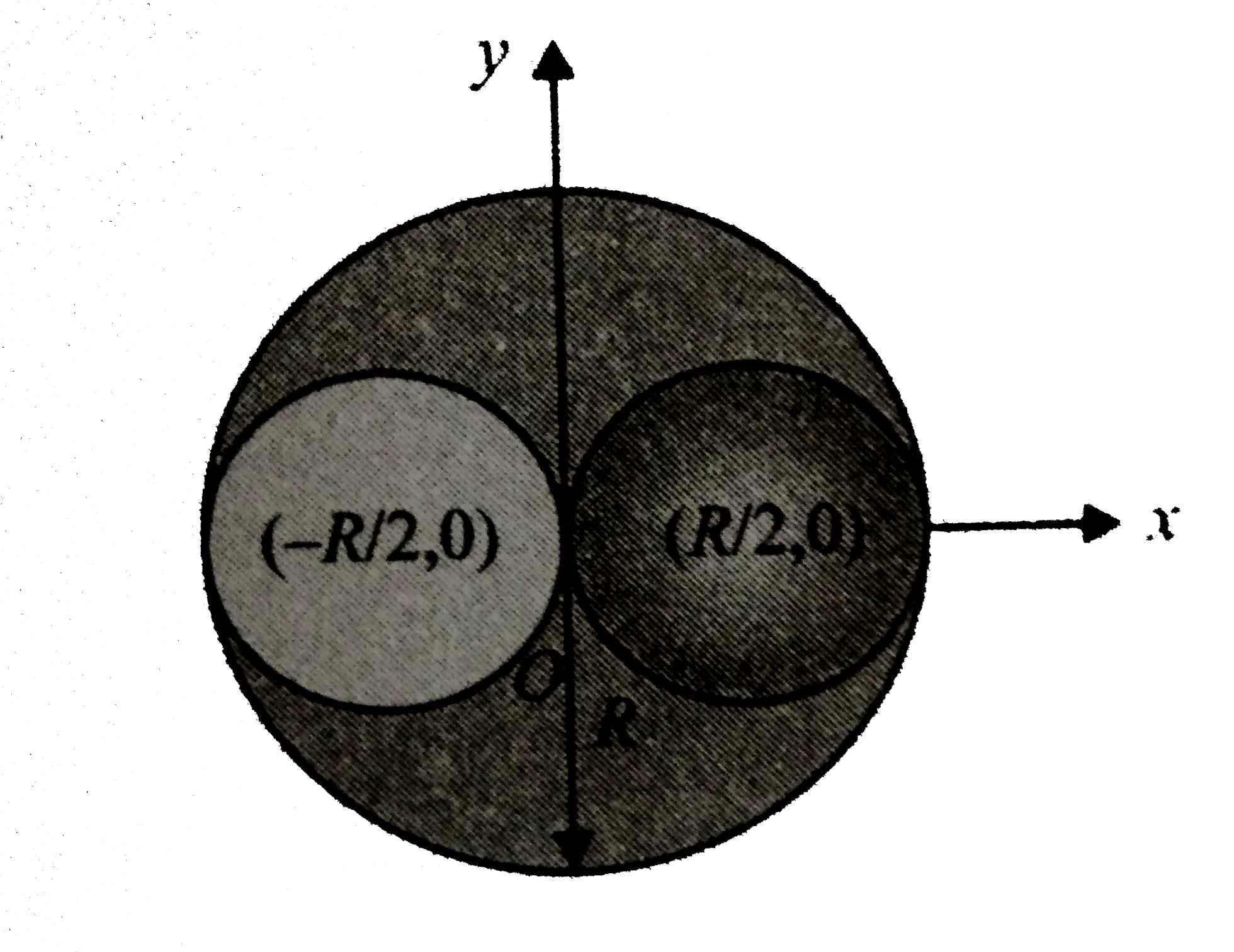 03:02View Solution
03:02View SolutionA projectile is fired at a speed of 100 m/s at an angel of `37^0` above the horizontal. At the highest point, the projectile breaks into two parts of mass ratio 1:3 the smaller coming to rest. Find the distance from the launching point to the where the heavier piece lands.
 04:52View Solution
04:52View SolutionTwo balls with masses `m_(1)=3` and `m_(2)=5`kg have initial velocities `v_(1)=v_(2)=5m//s` in the directions shown in figure. They collide at the origin.
a. find the velocioty of the CM `3s` before the collision.
b. Find the position of the CM `2s` after the collision.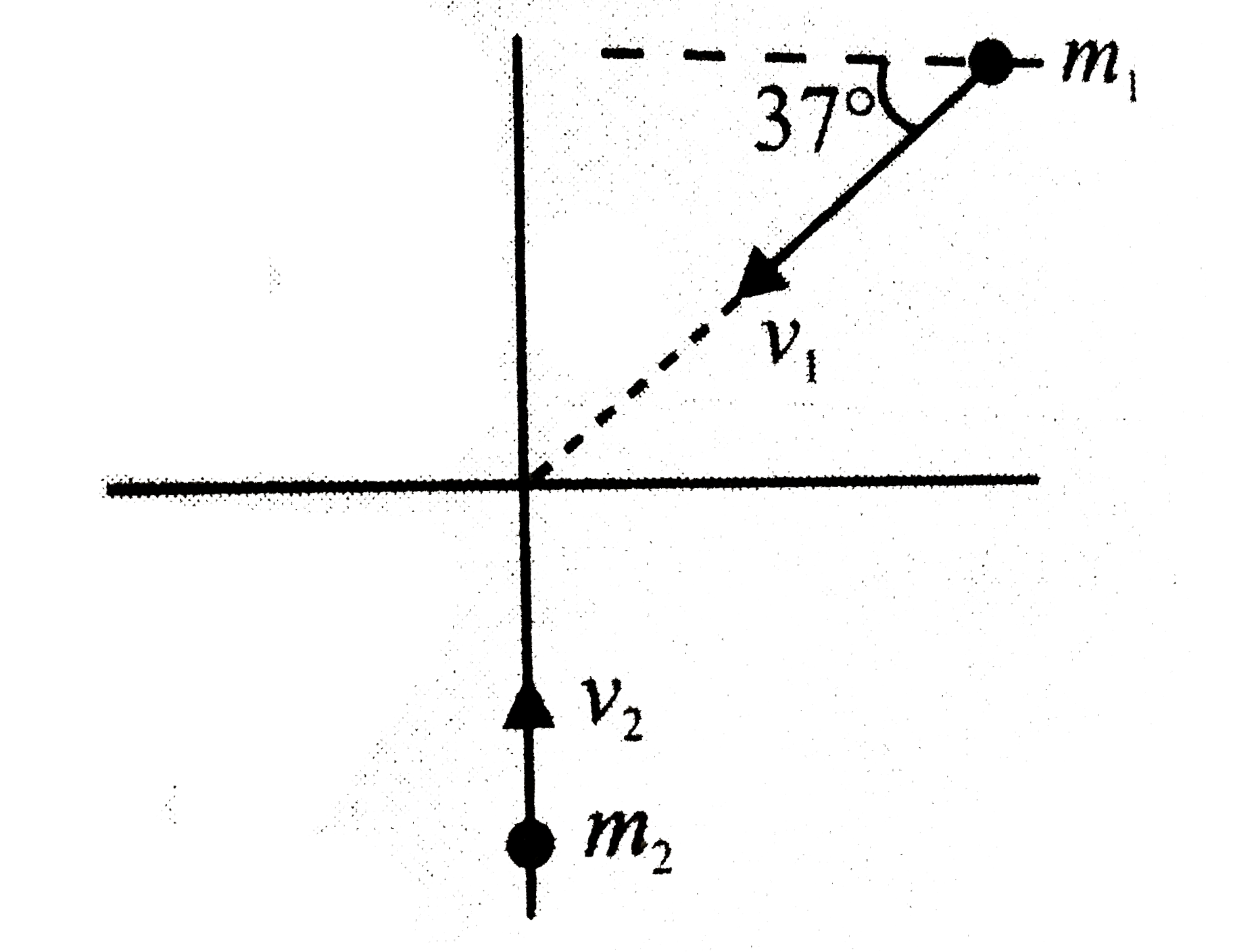 03:54View Solution
03:54View SolutionTwo masses `nm` and `m`, start simultaneously from the intersection of two straight lines with velocities `v` and `nv` respectively. It is observed that the path of their centre of mass is a straight line bisecting the angle between the given straight lines. Find the magnitude of the velocity of centre of mass. [Here `theta=`angle between the lines]
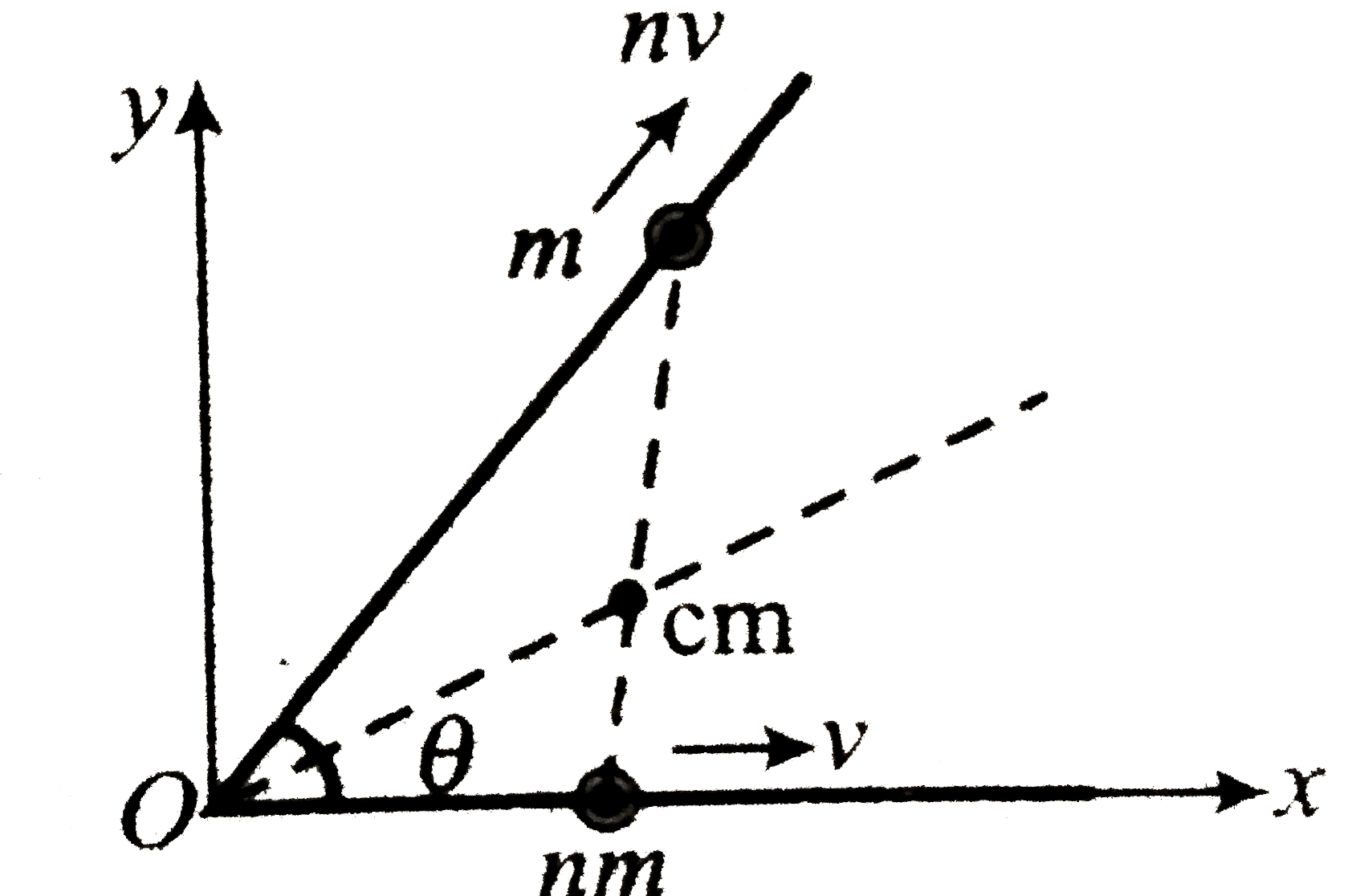 05:45View Solution
05:45View SolutionTwo blocks `A` and `B` each of equal masses `m` are rleased from the top of a smooth fixed wedge as shown in the figure. Find the magnitude of the accelertion of the centre of mass of the two blocks.
 03:52View Solution
03:52View SolutionTwo particles of masses `2 kg` and `4 kg` are approaching towards each other with ccelerations `1m//s^(2)` and `2m//s^(2)`, respectively, on a smooth horizontal suface. Then find the acceleration of centre of mass of the system and direction of acceleration of CM.
01:30View SolutionA pulley fixed to the ceiling carried a thread with bodies of masses `m_(1)` and `m_(2)` attached to its ends. The mases of the pulley and the thread are negligible and friction is absent. Find the acceleration of the centre of mass of this system.
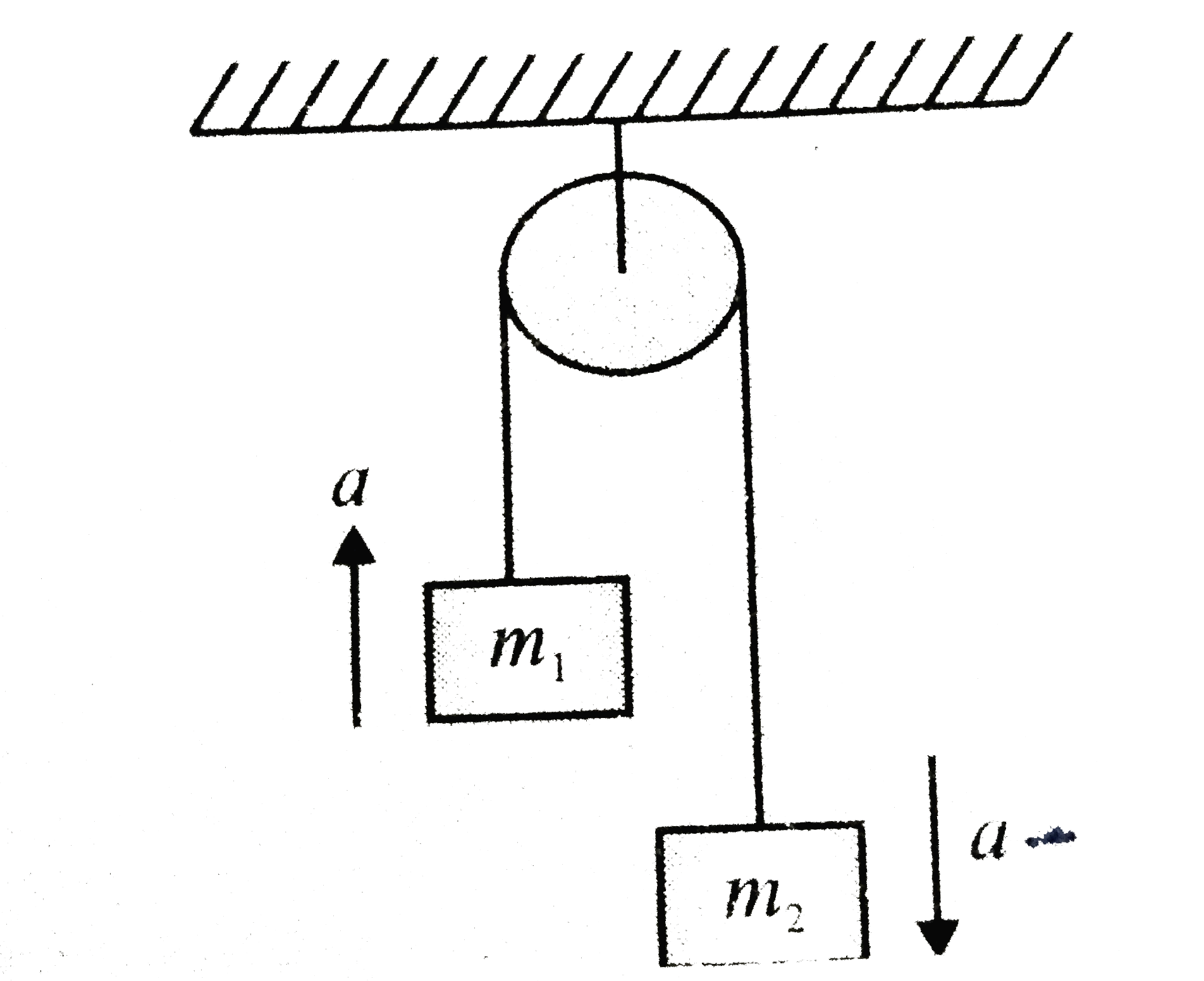 02:35View Solution
02:35View SolutionA log of wood of length `l` and mass `M` is floating on the surface of a river perpendicular to the banks. One end of the log touches the banks. A man of mass `m` standing at the other end walks towards the bank. Calculate the displacement of the log when he reaches nearer end of the log
03:55View SolutionA plank of mas `M` and length `L` is at rest on as frictionless floor. The top surface of the plank has friction. At one end of it a man of mass `m` is standing as shown in figure. If the man walks towards the other end the find the distance, which the plank moves a till the man reaches the centre of the plank. b. till the man reaches the other end of the plank.
 03:00View Solution
03:00View SolutionAn explosion blows a rock into three parts. Two pieces go off at right angles to each other, `1.0 kg` piece with velocity of `12 m//s` and other , `1.0 kg` piece with a velocity of `12 m//s` and other `2.0 kg` piece with a velocity of `8 m//s`. If the third piece flies off with a velocity of `40 m//s` compute the mass of the third piece.
03:26View SolutionA uniform of mass `m` and length `L` is tied to a vertical shaft. It rotates in horizontal plane about the vertical axis at angular velocity `omega`. How much horizontal force does the shaft exert on the rod?
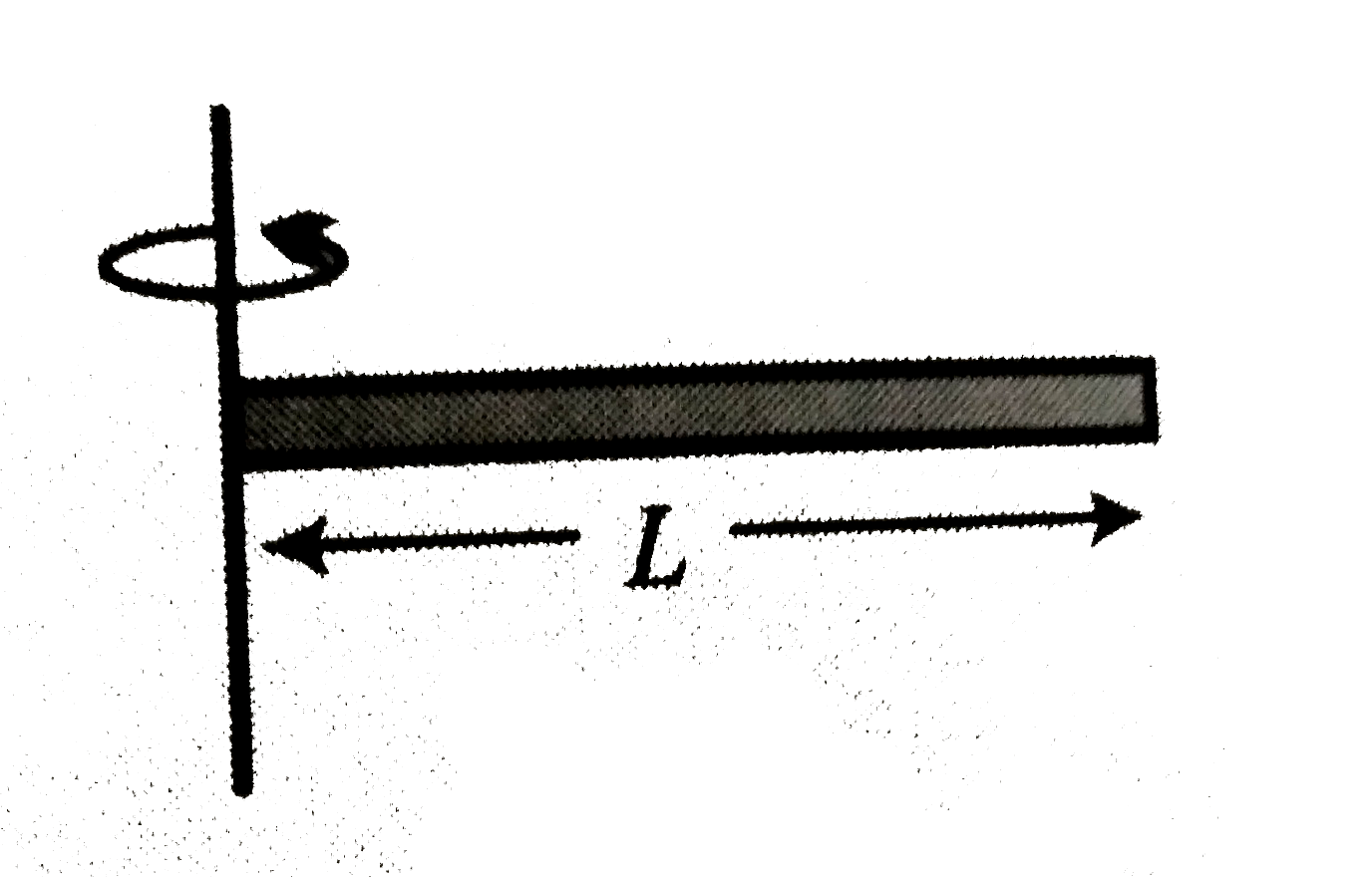 02:08View Solution
02:08View SolutionTwo balls of equal mass are projected upwards simultaneously, one from the ground with initial velocity `50ms^-1` and the other from a `40m` tower with initial velocity of `30ms^-1`. The maximum height attained by their COM will be a) 80 m b) 60 m c) 100 m d) 120 m
05:55View SolutionA body of mass explodes at rest break up into three parts.If two parts having equal masses fly off perpendicularly to each other with a velocity of `18 m//s`, then calculate the velocilty of the third part which has a mass `3` times the mass of each part.
04:14View SolutionA man of mass `m` moves on a plank of mass `M` with a constant veloicty `u` with respect to the plank, as shown in figure.
a.If the plank rest on smooth horizontal surface, determine the velocity of the plank.
b If the man travels a distasnce `L` with respect to the plank, find the distance travelled by the plank with respect to te ground.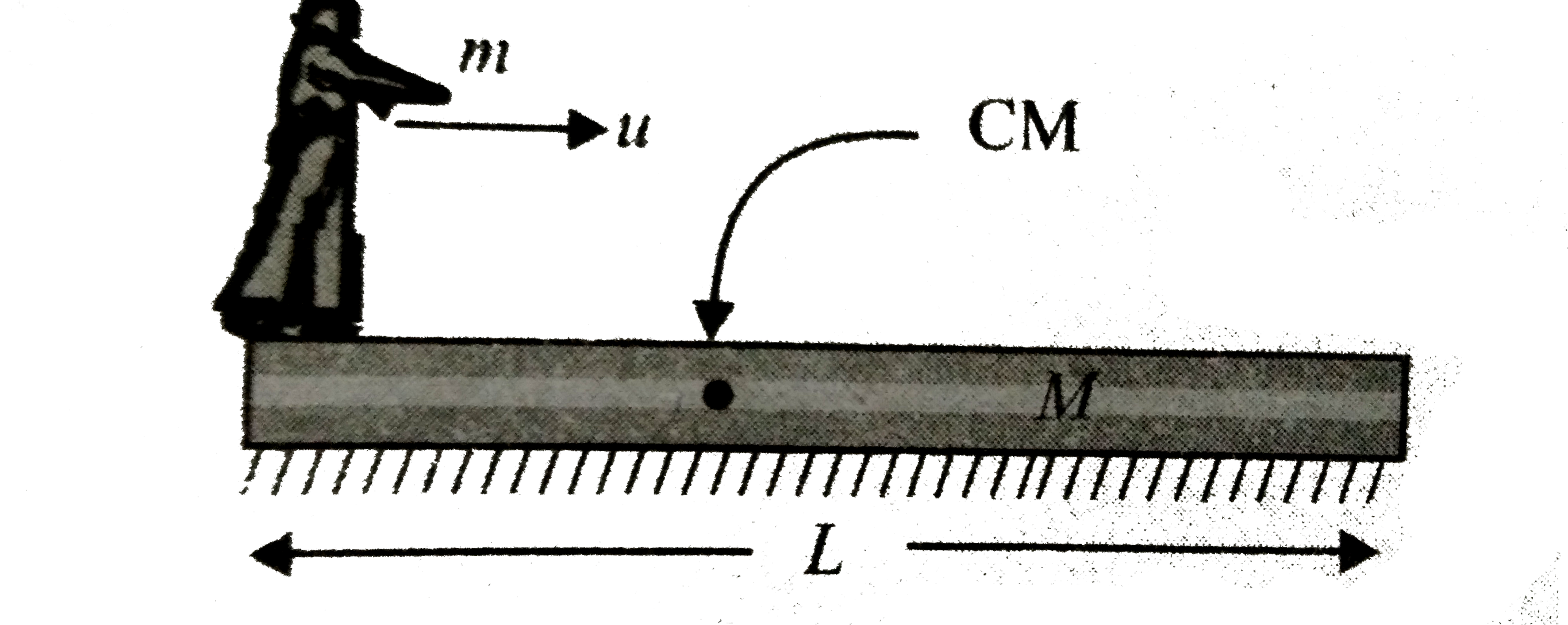 03:51View Solution
03:51View SolutionA shell is fired from a cannon with a velocity V at an angle `theta` with the horizontal direction. A the highest point i its path, it explodes into two pieces of equal masses. One of the pieces retraces its path to the cannon. The speed of the other priece immediately after the explocison is
02:37View SolutionA man of mass `m` runs without sliding from rest from one end of a boat of mass `M` and length `l` with an acceleration a relative to the boat. If the friction between water and boat is neglected find the
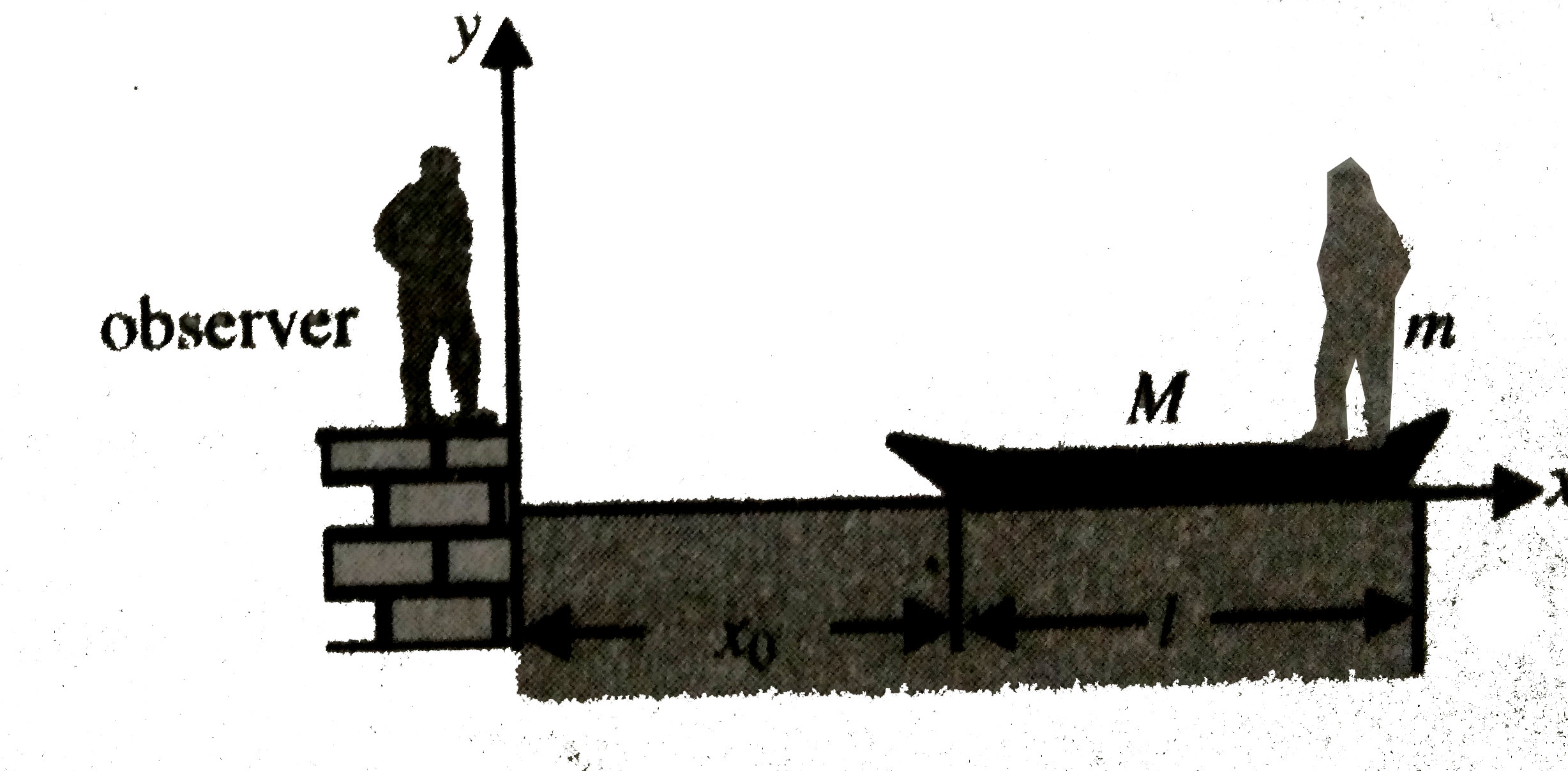
a. acceleration of CM of the system `(M+m)`
b. acceleration of the man and boat
c. position of man at the time when he reaches to other end of the boat
d. frictional force
e. work done by friction on boat.
f. total work done by friction.
g. velocities of man and boat when the man reaches other end of the boat.
h. work down by man21:07View SolutionTwo trucks of mass `M` each are moving in opposite direction on adjacent parallel tracks with same velocity `u`. One is carrying potatoes and other is carrying onions, a bag of potatoes has a mass `m_(1)` and a bag of onions has a mass `m_(2)` (included i the mass of truck `M`). When trucks get close to each other while passing the drivers exchange a bag with the other one by throwing the other one. Find the final velocities of the trucks after exchange of the bags.
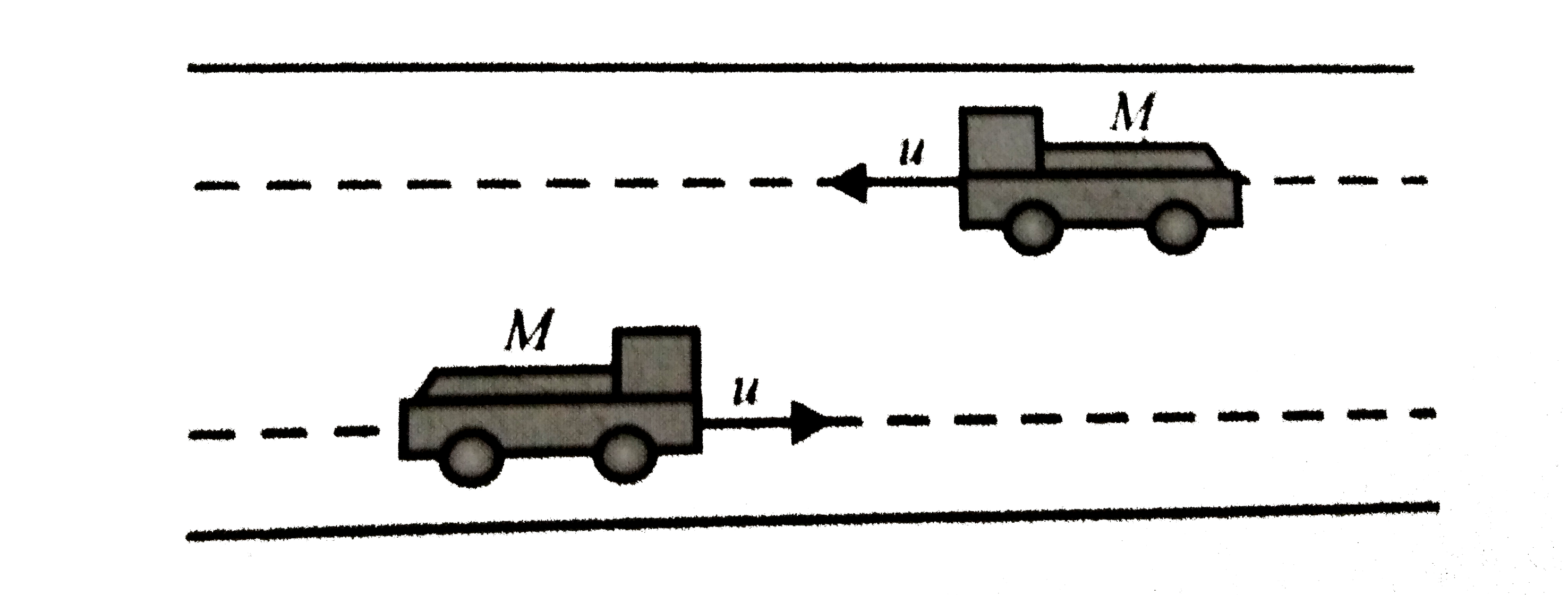 07:17View Solution
07:17View SolutionA flat car of mass `M` is at rest on a frictionless floor with a child of mass `m` standing at its edge. If the child jumps off from the car towards right with an initial velocity `u`, with respect to the car, find the velocity of the car after its jump.
04:08View SolutionTwo blocks of masses `m_(1)` and `m_(2)` interconnect with a spring of stiffness `K`, are kept on as smooth horizontal surface. Find out the ratio of velocity, displacement, kinetic energy and acceleration block with mass `m_(1)` of block with mass `m_(2)`.
04:15View SolutionTwo identical buggies move one after the other due to inertia (without friction) with the same velocity `v_0`. A man of mass m rides the rear buggy. At a certain moment the man jumps into the front buggy with a velocity u relative to his buggy. Knowing that the mass of each buggy is equal to M, find the velocities with which the buggies will move after that.
02:33View SolutionA flat car of mass `m` is at rest on a frictionless floor with a child of mass `m` standing at its edge. If the child jumps off from the car towards right with an initial velocity `u`, with respect to the car, find the velocity of the car after its jump.
04:08View SolutionA light spring of spring constant k is kept compressed between two blocks of masses m and M on a smooth horizontal surface. When released, the blocks acquire velocities in opposite directions. The spring loses contact with the blocks when it acquires natural length. If the spring was initially compressed through a distance d find the final speeds of the two blocks.
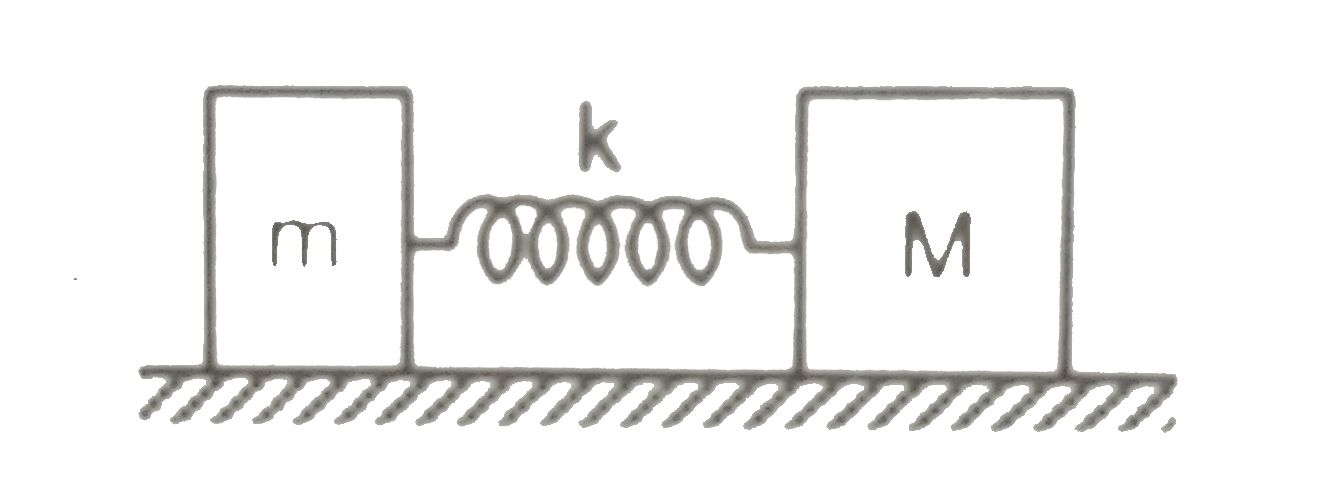 05:15View Solution
05:15View SolutionA block of mass `m` is connected to another block of mass `M` by a massless spring of spring constant `k`. the blocks are kept of a smooth horizontal plane and are at rest. The spring is unstretched when a constant force `F` starts acting on the block of mass `M` of pull it. Find the maximum extension of the spring
 05:01View Solution
05:01View SolutionTwo small discs of masses `m_(1)` and `m_(2)` are connected by a weightless spring resting on a smooth horizontal plance. The discs are set in motion with initial velocities `v_(1) and v_(2)` whose directions are mutually perpendicular and in the same horizontal plane. Find the total energy `E` of the system with reference to the frame fixed to the centre of mass.
 03:49View Solution
03:49View SolutionTwo smooth blocks of mases `m_(1) and m_(2)` attached with an ideal spring of stiffness `k` and kept on hrozontal surface. If `m_(1)` is projected with a horizontal velocity `v_(0)`. Find the maximum compression of the spring.
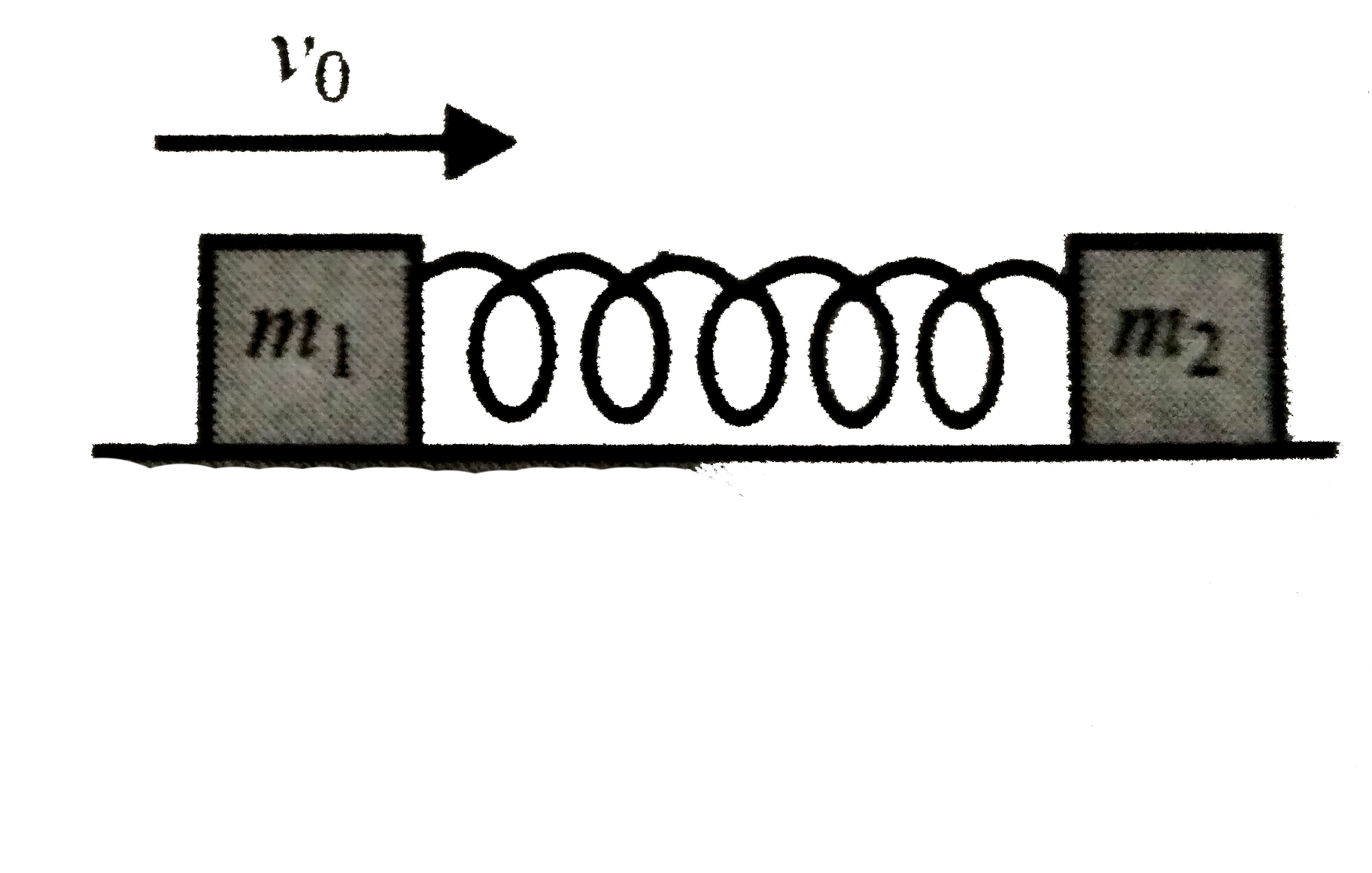 02:25View Solution
02:25View SolutionA block of mass `m` is pushed with a velocity `v_(0)` along the surface of a trolley car of mass `M`. If the horizontal ground is smooth and the coefficient of kinetic friction between the block of plank is `mu`. Find the minimum distance of relative sliding between the block and plank.
 03:26View Solution
03:26View SolutionA smooth wedge of mass `M` rests on a smooth horizontal surface. A block of mass `m` is projected from its lowermost point with velocity `v_(0)`. What is the maximum height reached by the block?
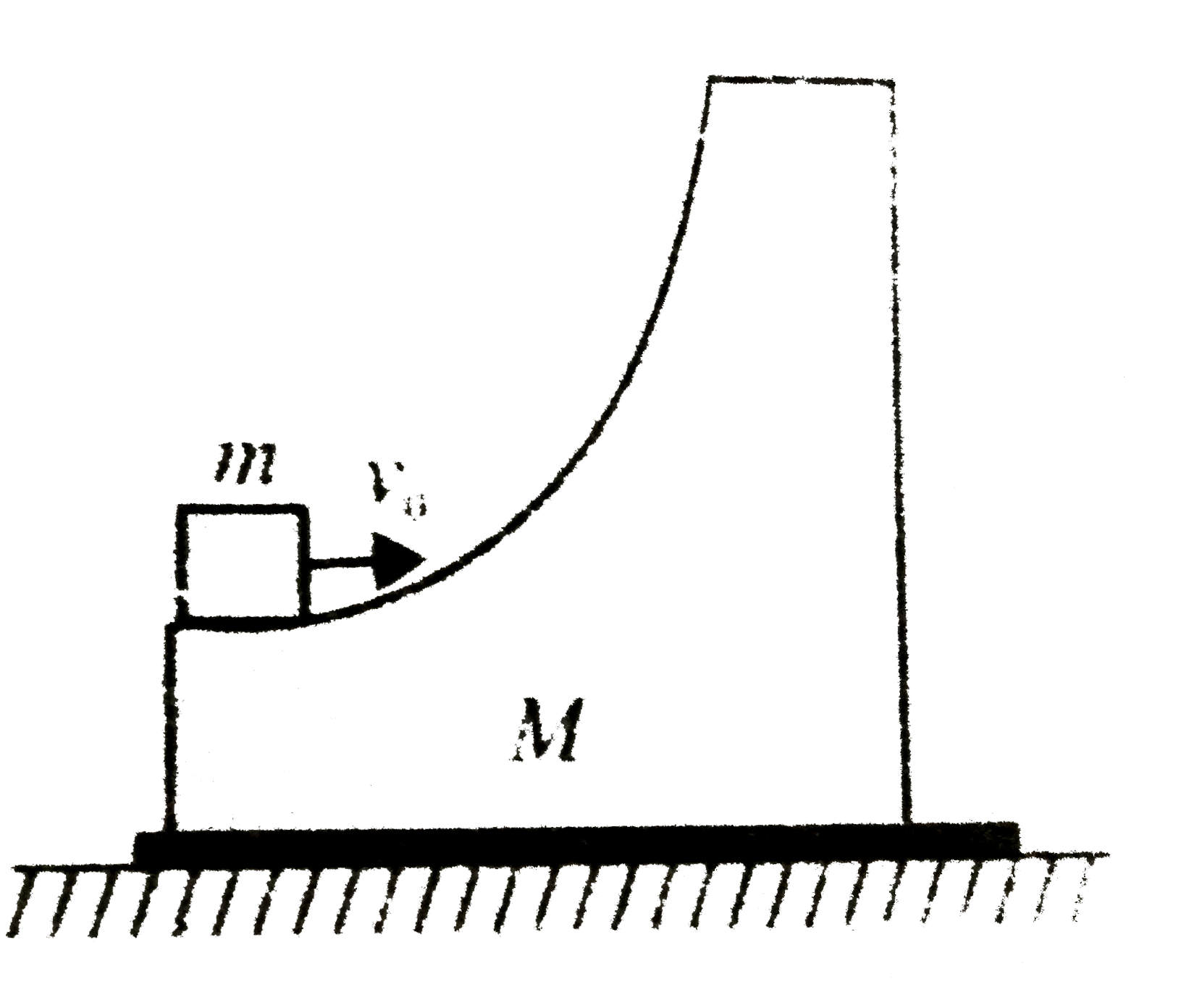 03:04View Solution
03:04View SolutionThe hero of a stunt film fires 50 g bullets from a machine gun, each at a speed of 1.0 km/s. If he fires 20 bullets in 4 seconds. What average force does he exert against the machine gun during this period?
02:49View SolutionA block of mass m and a pan of equal mass are connected by a string going over a smooth light pulley as shown in figure. Initially the system is at rest when a particle of mass m falls on the pan and sticks to it. If the particle strikes the pan with a speed v find the speed with which the system moves just after the collision.
05:53View SolutionTwo identical blocks `A` and `B` connected by massless string, are placed on a frictionless horizontal plane. A bullet havig the same mass, moving with speed `u` strickes block `B` from behind as shown. If the bullet gets embedded into block `B` then find
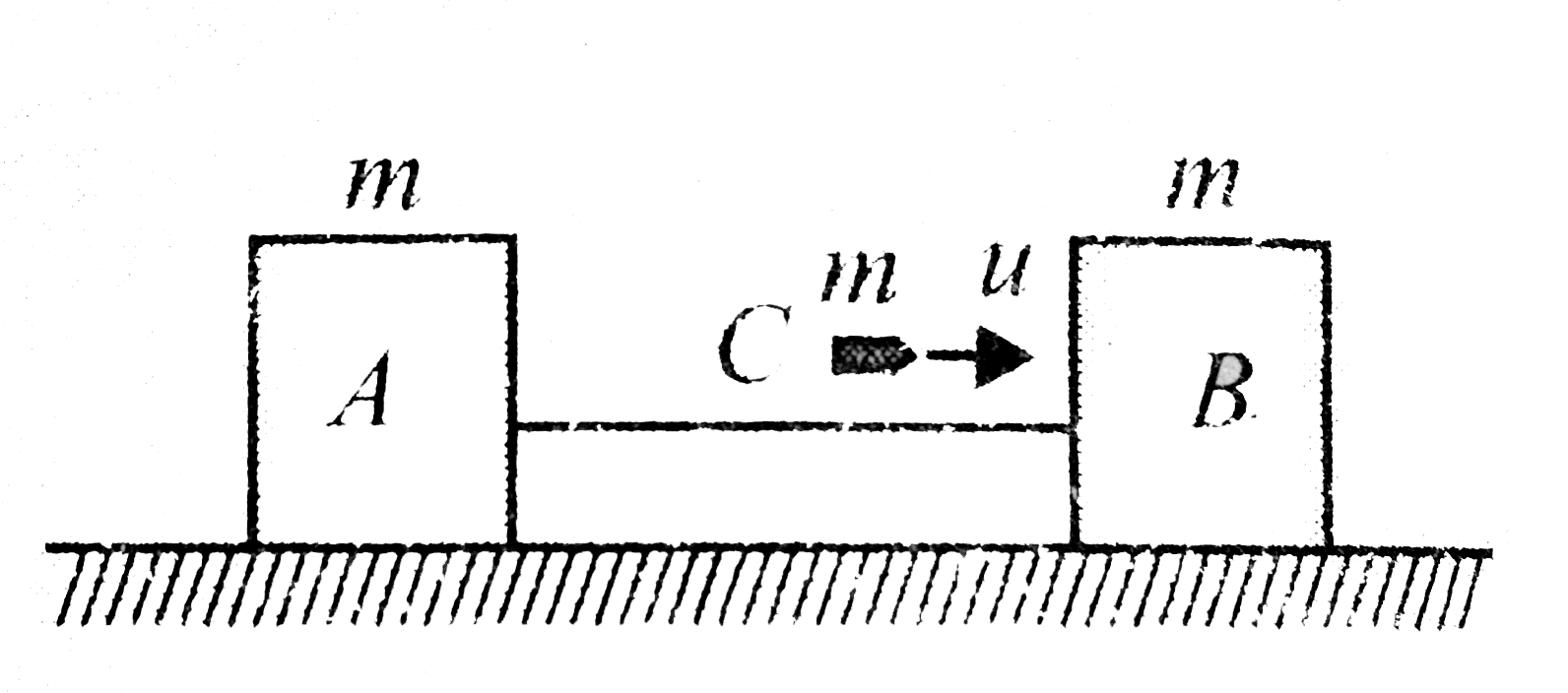
a. the velocity of `A,B,C` after collision.
b. impulse on `A` due to tension in the string,
c. impulse on `C` due to normal force of collision,
d. impulse on `B` due to normal force of collision.02:23View SolutionA ball of mass `1kg` is attached to an inextensible string. The ball is released from the position shown in figure. Find the impulse imparted by the string to the ball immediately after the string becomes taut. (Take `g=10m//s^2`)
 02:45View Solution
02:45View SolutionTwo particles A and B each of mass m are attached by a light inextensible string of length 2l . The whole system lies on a smooth horizontal table with B initially at a distance l from A . The particle at end B is projected across the table with speed u perpendicular to AB . Velocity of ball A just after the string is taur , is
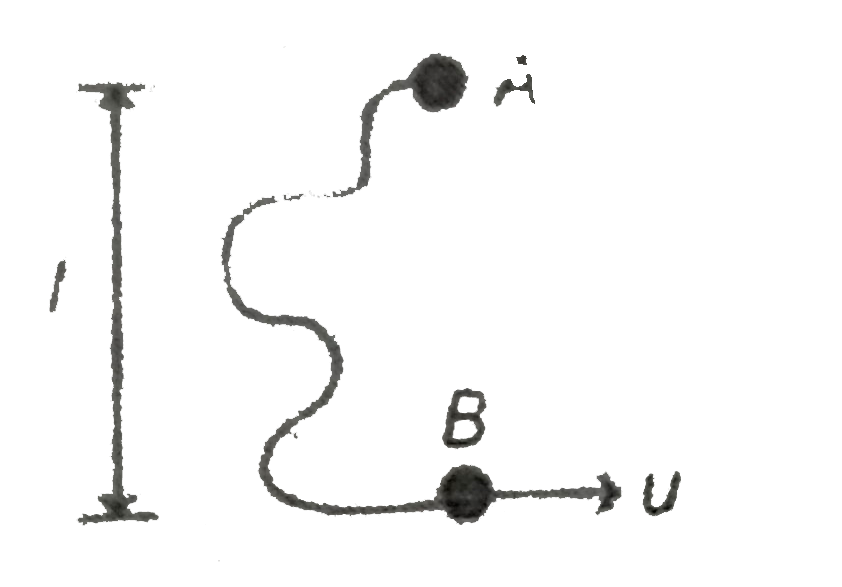 05:52View Solution
05:52View SolutionA sphere of mass `m` slides with velocity `v` on as frictionless surface towards a smooth inclined wall as shown in figure. If the collision with the wall is perfectly elastic find a. the impulse imparted by the wall on the sphere `b` the impulse imparted by the floor on the sphere.
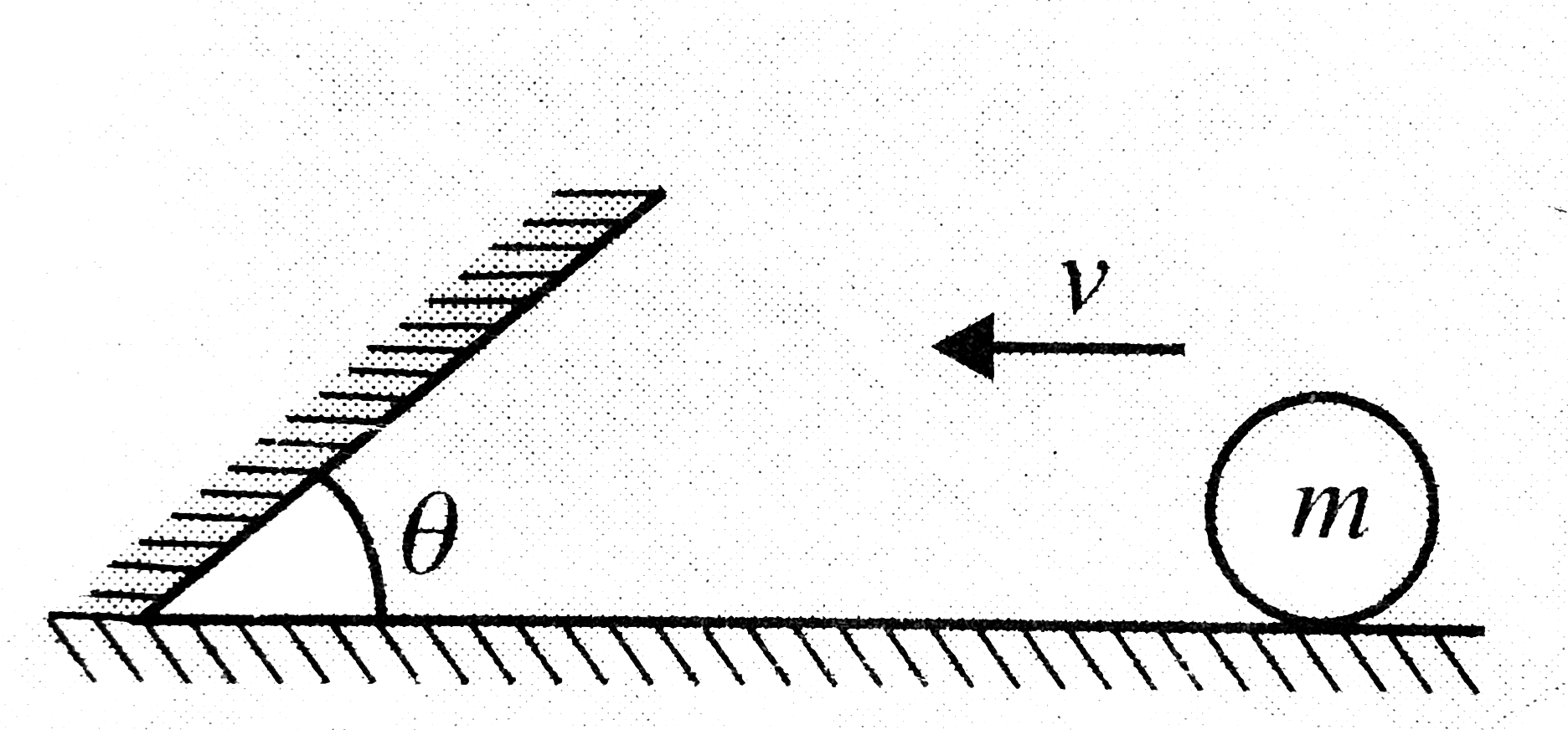 03:08View Solution
03:08View SolutionA mass 2 m rests on a horizontal table . It is attached to a light inextensible string which passes over a smooth pulley and carries a mass m is raised vertically through a distance h and is then dropped , then the speed with which the mass 2 m begins to rise is
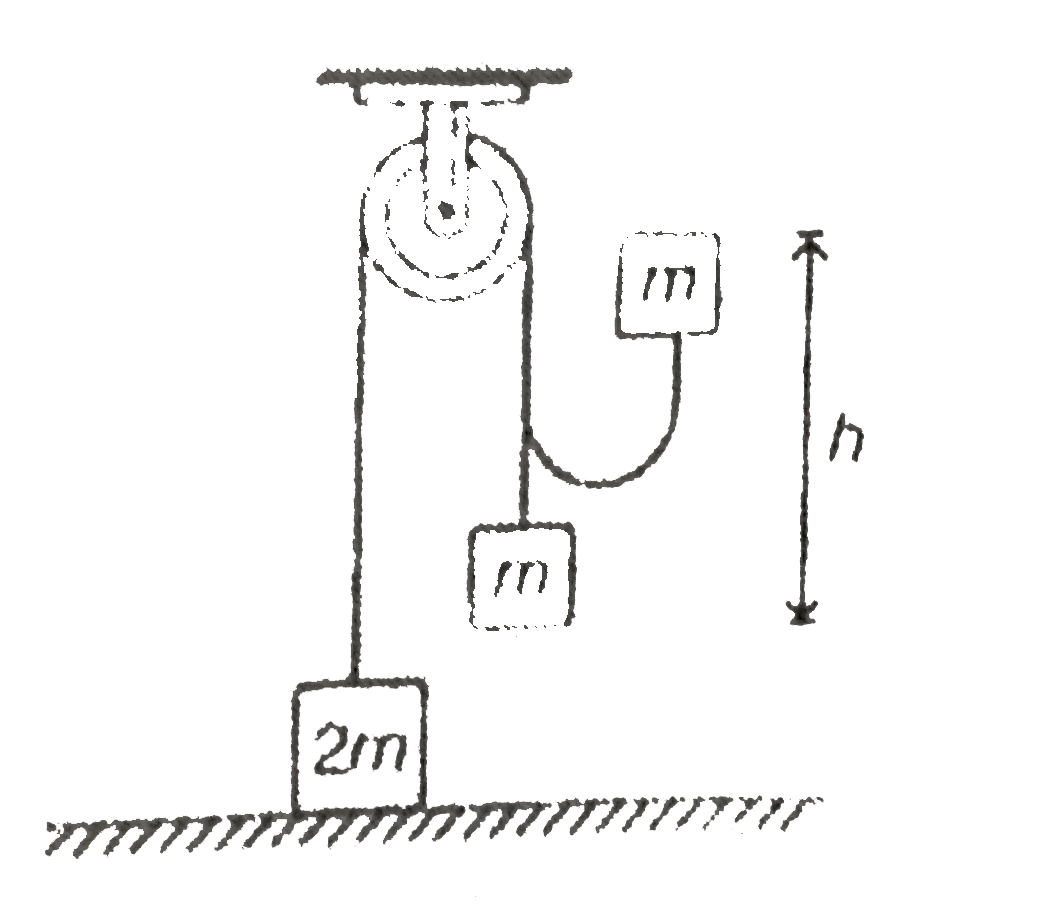 02:41View Solution
02:41View SolutionTwo particles of masses `m_(1)` and `m_(2)` are connected by a light and inextensible string which passes over a fixed pulley. Initially, the particle `m_(1)` moves with velocity `v_(0)` when the string is not taut. Neglecting fricting in all contacting surface, find the velocities of the particles `m_(1)` and `m_(2)` just after the string is taut.
 02:13View Solution
02:13View SolutionA ball is projected from a given point with velocity u at some angle with the horizontal and after hitting a vertical wall returns to the same point. Show that the distance of the point from the wall must be less than `(eu^2)/((1+e)g)`, where e is the coefficient of restitution.
05:48View SolutionWhat will be the angle of reflection in case of an inelastic collision and `v=`?
02:38View SolutionIf a ball strickes with a velocity `u_(1)` at the wall which itself is approaching it with a velocity `u_(2)` then find the velocity of the ball after collision with the wall.
02:19View SolutionA tennis ball bounces down a flight of stairs striking each step in turn and rebounding to the height of the step above . The coefficient of restitution is
04:34View SolutionA ball of a mass m hits the floor with as speed v making an angle of incidence `theta` with the normal. The coefficient of restitution is e. Find the speed of the reflected ball and the angle of reflection of the ball.
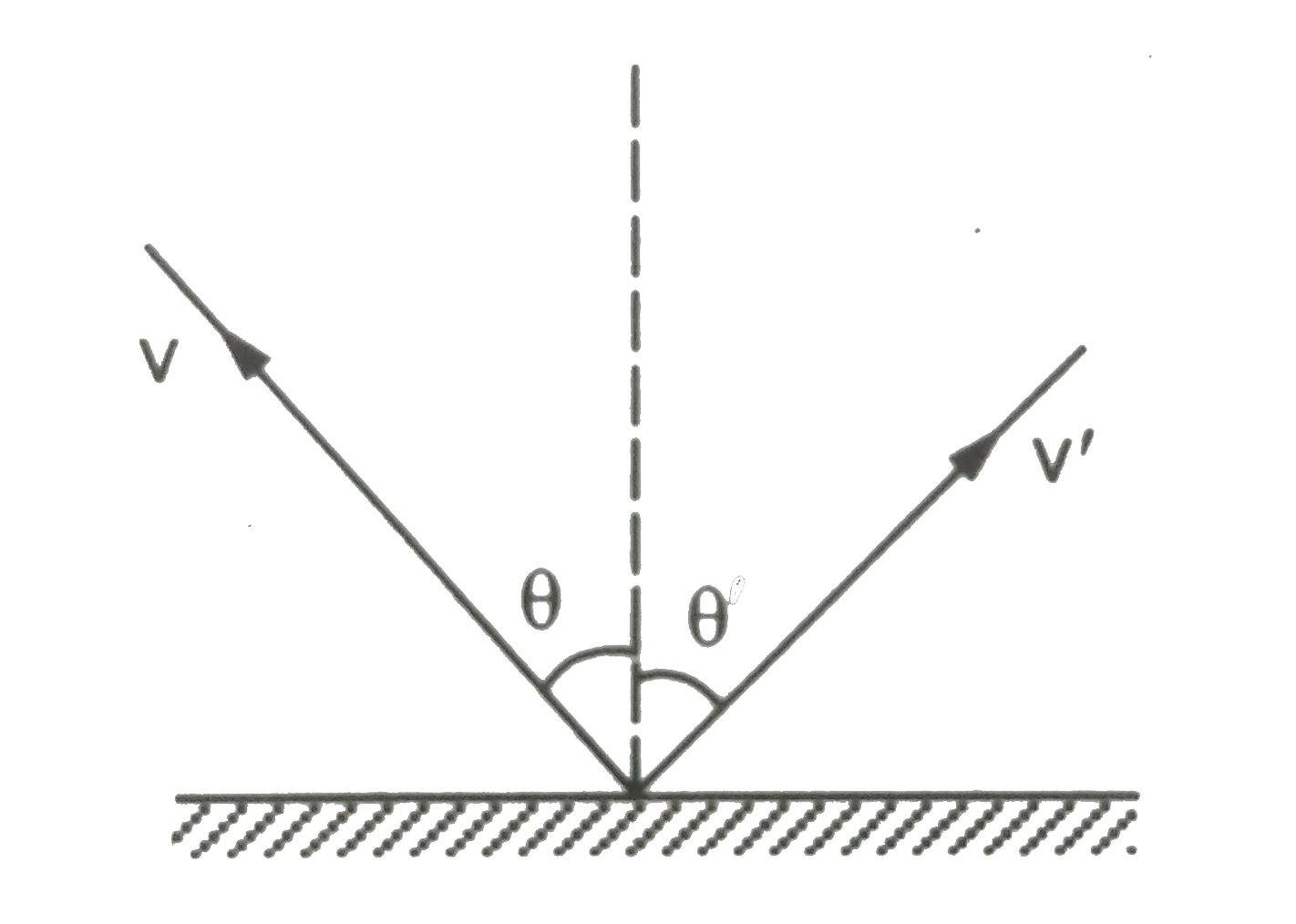 `View Solution
`View SolutionTwo identical balls are approaching towards each other on a straight line with velocity `2m//s` and `4m//s`, respectiely. Find the final velocities after elastic collision between them.
 05:06View Solution
05:06View SolutionThree balls `A, B` and `C` of same mass `m` are placed on a frictionless horizontal plane in a straight line as shown. Ball `A` is moved with velocity `u` towards the middle ball `B`. If all the collisions are elastic, find the final velocities of all the balls.
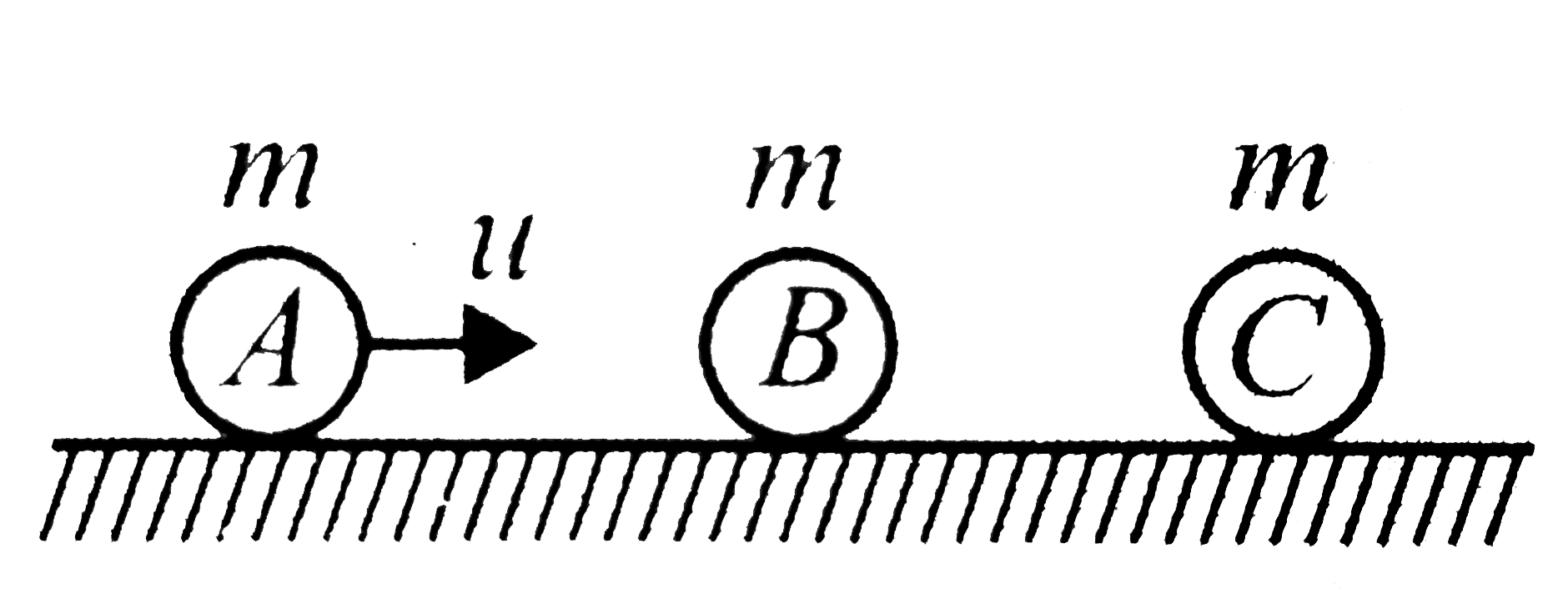 01:48View Solution
01:48View SolutionFour identical balls `A,B, C` and `D` are placed in a line on frictionless horizontal surface. `A` and `D` are moed with the same speed `u` towards the middle as shown. Assuming elastic collisions, find the final velocities.
 02:46View Solution
02:46View SolutionTwo particles of masses `m` and `2m` moving in opposite directions collide elastically with velocity `2v` and `v`, respectiely. Find their velocities after collision.
 02:30View Solution
02:30View SolutionA ball of mass m moving at a speed v makes a head on inelastic collision with an identical ball at rest. The kinetic energy of the balls after the collision is `3/4th` of the original. Find the coefficient of restitution.
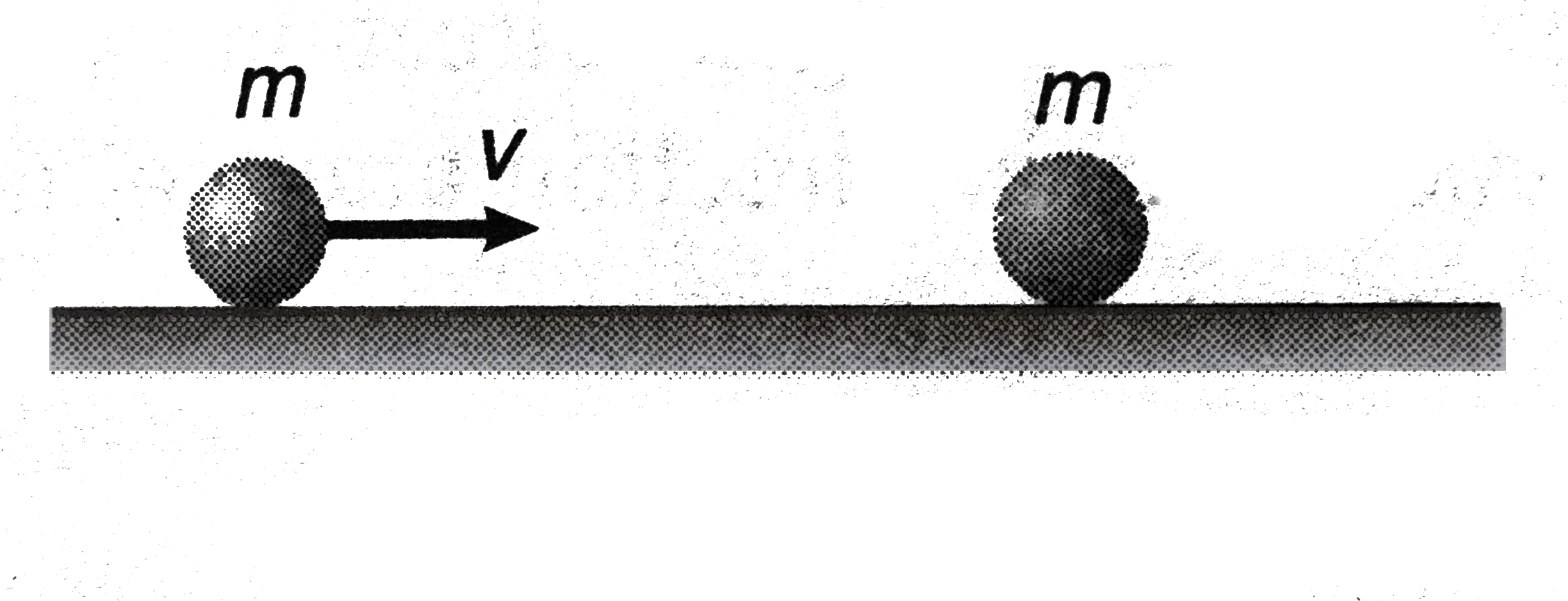
 04:01View Solution
04:01View SolutionA ball is moving with velocity `2ms^(-1)` towards a heavy wall moving towards the ball speed `1ms^9-1)` as shown in figure. Assuming collision to be elastic, find the velocity of ball immediately after the collision
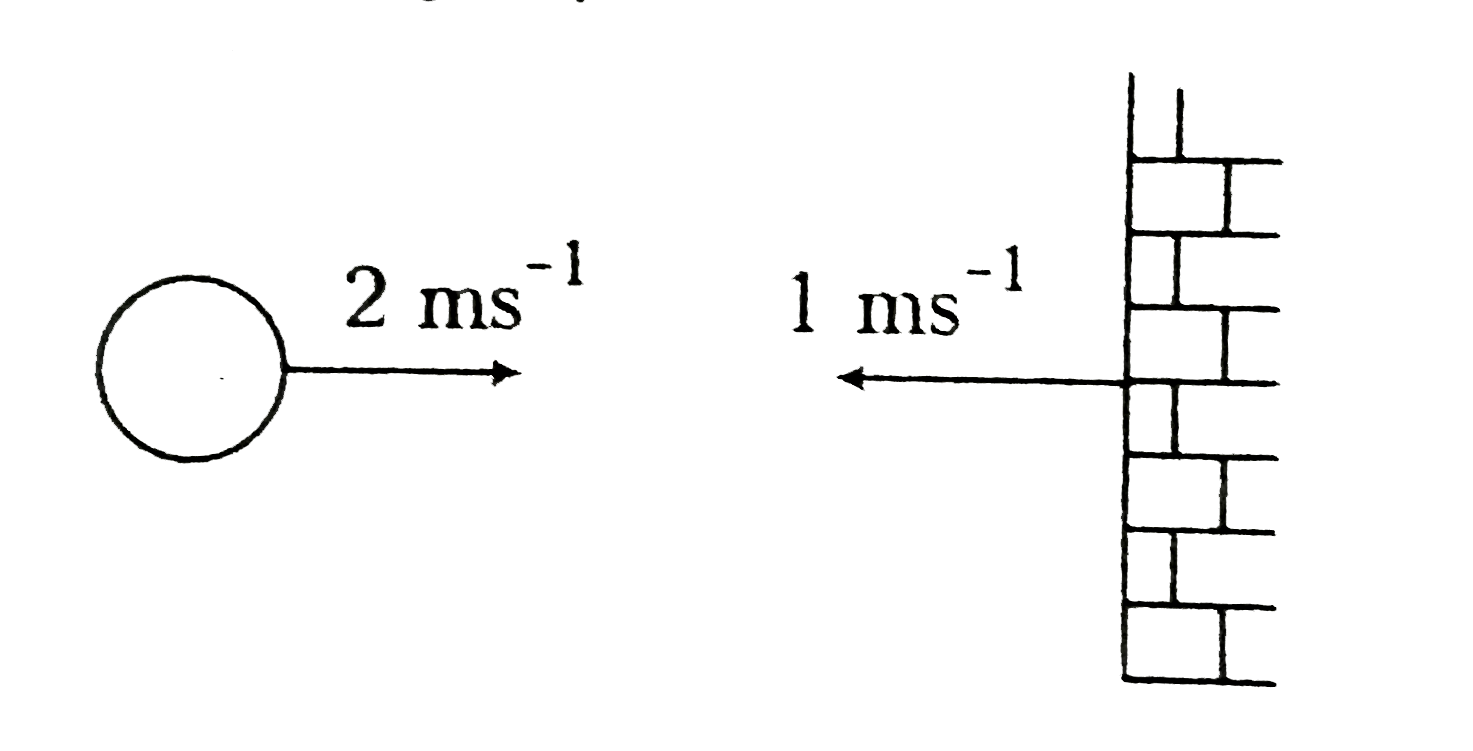 02:50View Solution
02:50View SolutionTwo balls of masses `2 kg` and `4 kg` are moved towards each other with velocities `4m//s` and `2m//s`, respectively, on a frictionless surface. After colliding, the `2kg` ball returns back with velocity `2m//s`. then find
a. velocity of the `4 kg` after collision
b. coefficient of restitution e,
c. impulse of deformation `J_(D)`
d. maximum potential energy of deformation,
e. impulse of reformation `J_(R)` 04:52View Solution
04:52View SolutionTwo point prticles `A` and `B` are placed in line on frictionless horizontal plane. If particle `A` (mass `1 kg`) is move with velocity `10 m//s` towards stationary particle `B` (mass `2kg`) and after collision the two move at an angle of `45^(@)` with the initial direction of motion, then find
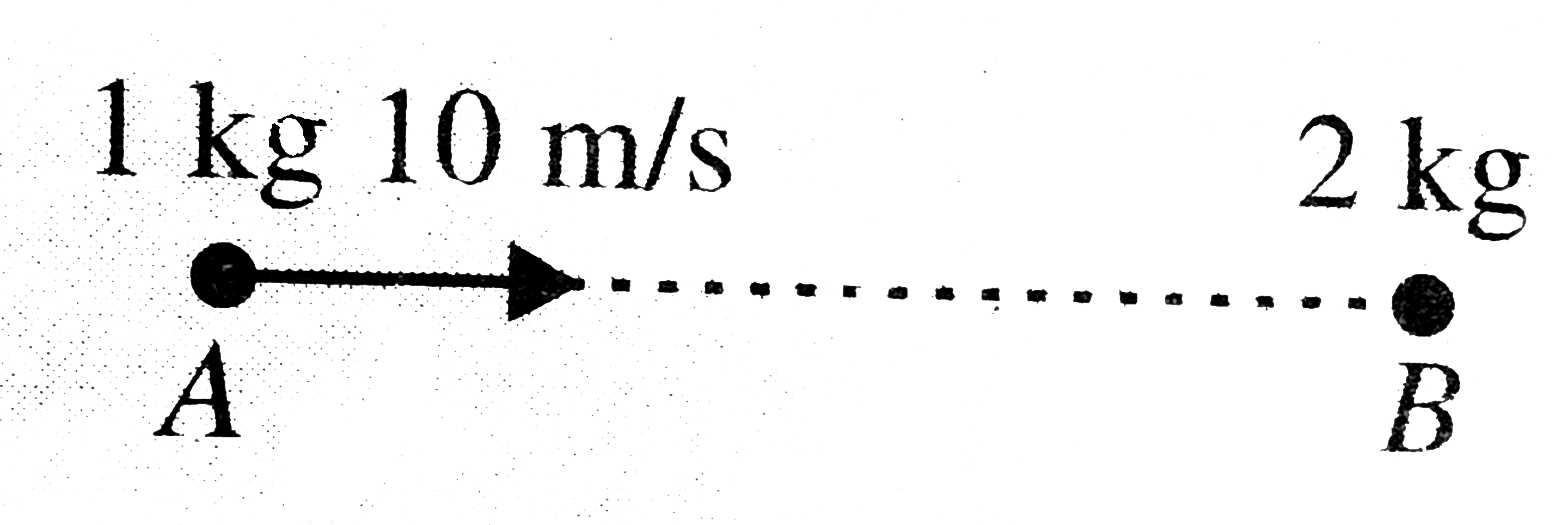
a. velocites of `A` and `B` just after collision.
b. coefficient of restitution04:24View SolutionA bullet of mass 50g if fired from below into the bob of mass 450g of a long simple pendulum as shown in Fig. The bullet remains inside the bob and the bob rises through a height of 1.8m. Find the speed of the bullet.Take `g=10 m/s^2`
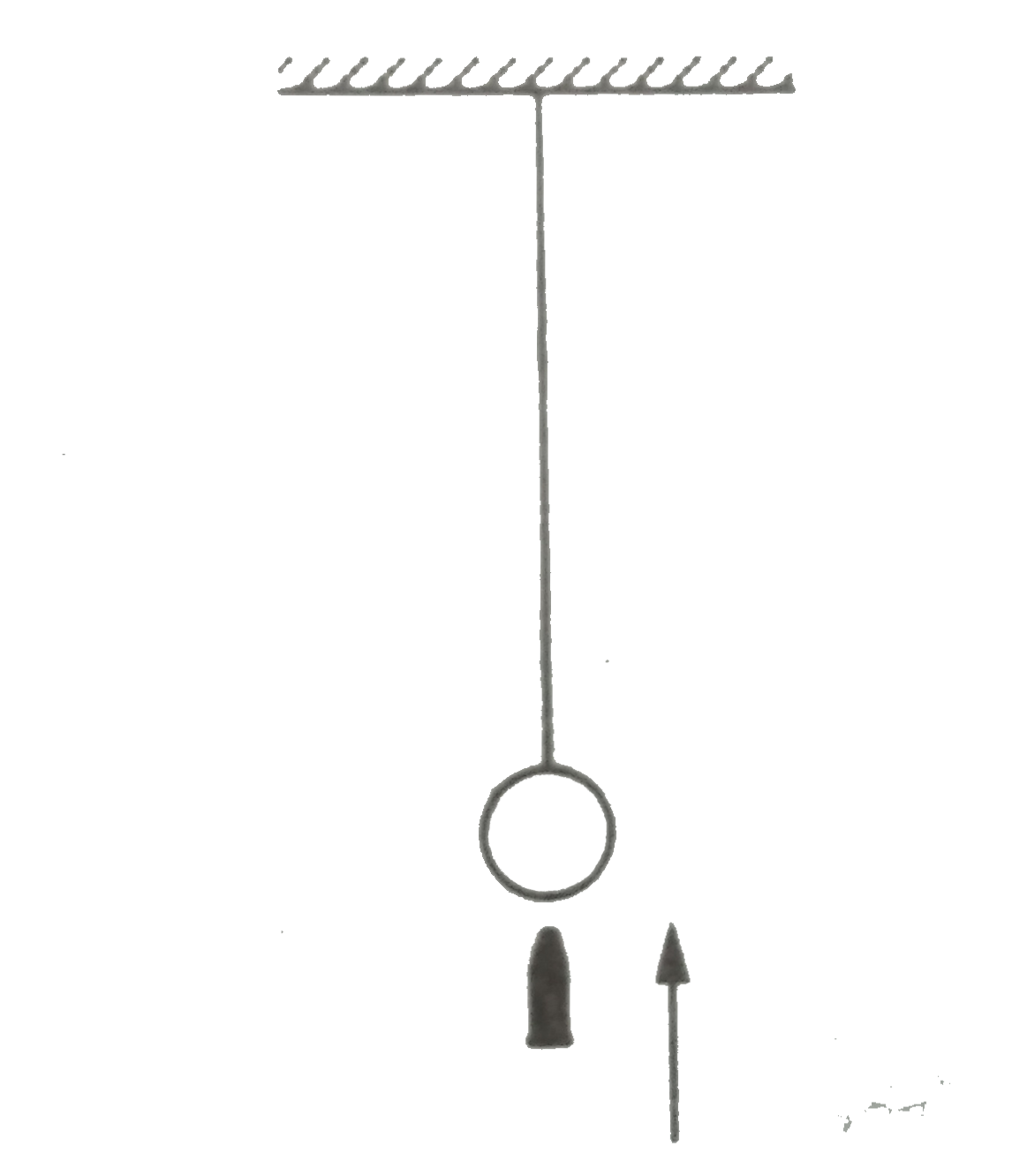 03:18View Solution
03:18View SolutionA small ball of mass `m` collides with as rough wal having coeficient of friction `mu` at an angle `theta` with the normal to the wall. If after collision the ball moves wilth angle `alpha` with the normal to the wall and the coefficient of restitution is `e`, then find the reflected velocity `v` of the ball just after collision.
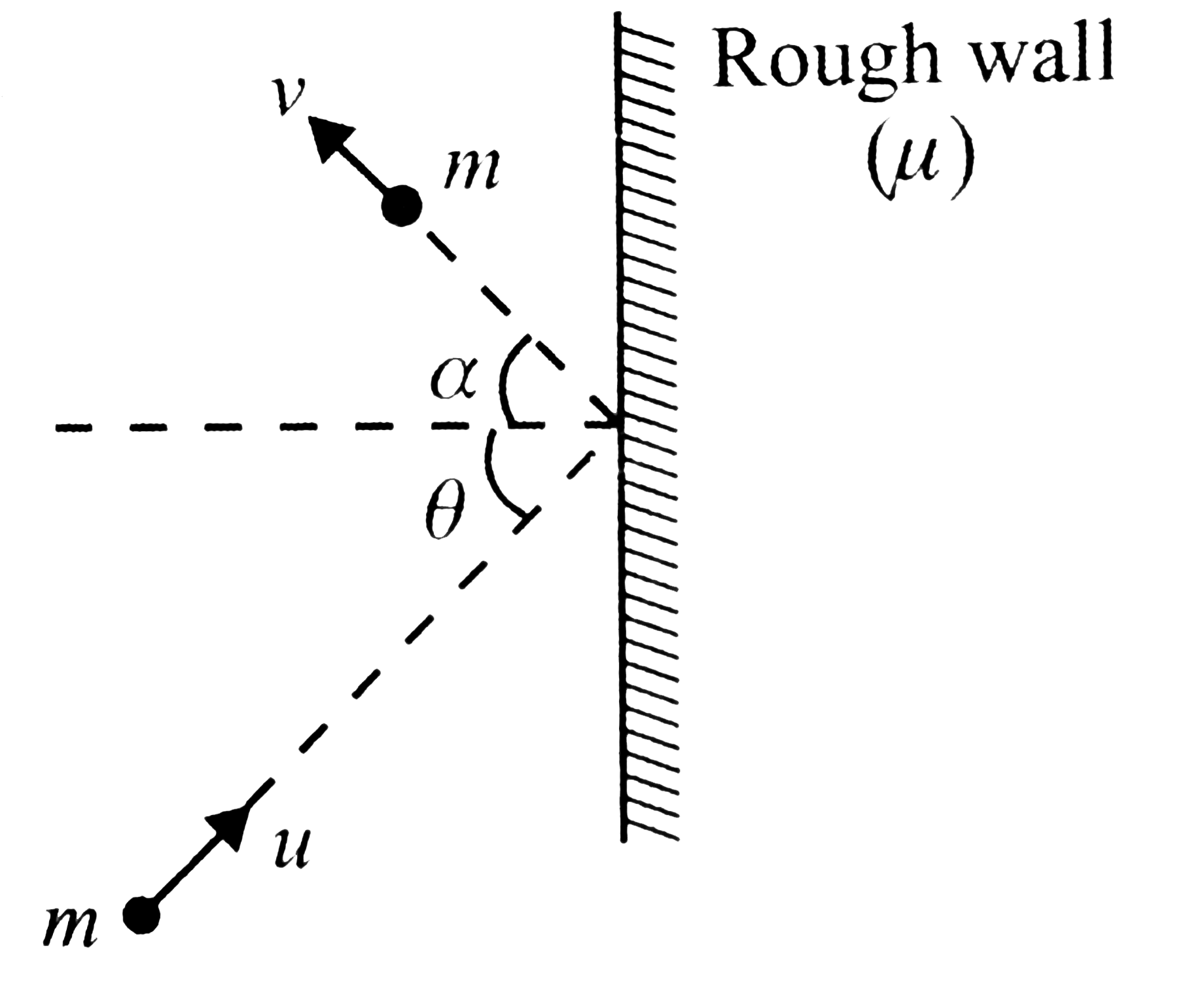 02:24View Solution
02:24View SolutionTwo equal spheres of mass `m` are in contact on a smooth horizontal table. A third identical sphere impinges symmetrically on the and is reduced to rest. Prove that `e=2/3` and find the loss in `KE`.
05:36View SolutionA particle (a mud pallet, say) of mass `m` strikes a smooth stationary wedge of mass `M` with as velocity `v_(0)` at an angle `theta` with horizontal. If the collision is perfectly inelastic, find the
a. velocity of the wedge just after the collision.
b. Change in `KE` of the system `(M+m)` in collision.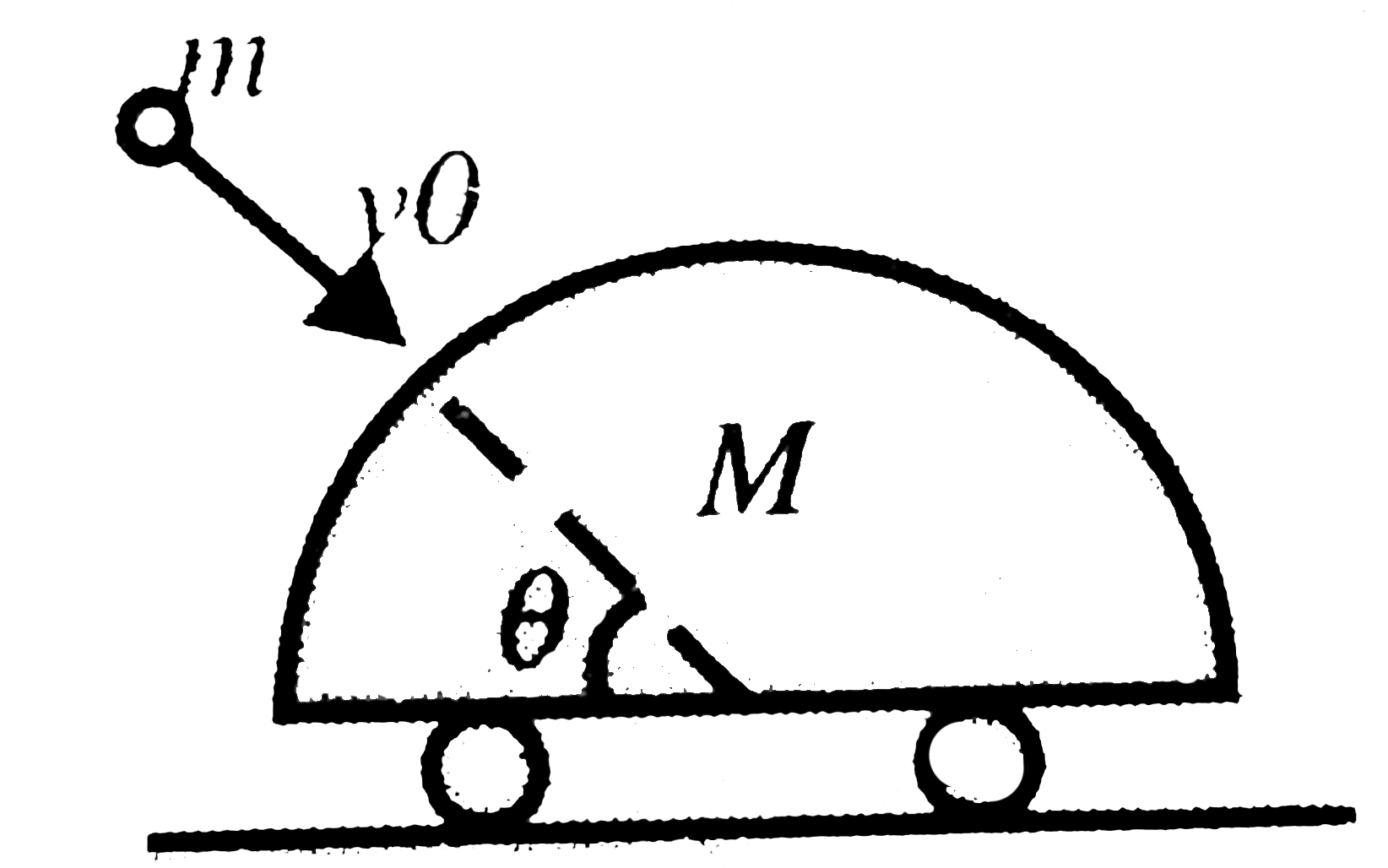 04:14View Solution
04:14View SolutionA ball of mass `m` moving horizotally which velocity `u` hits a wedge of mass `M`. The wedge is situated on a smooth horizontal source. If after striking with wedge the ball starts moving in vertical direction and the wedge starts moving in horizotal plane. calculate
a. the velocity of wedge `V`.
b. the velocity `(v)` at which the ball moves in vertical direction.
c. the impulse imparted by the ball on the wedge.
d. the coefficient of restitution `e=?`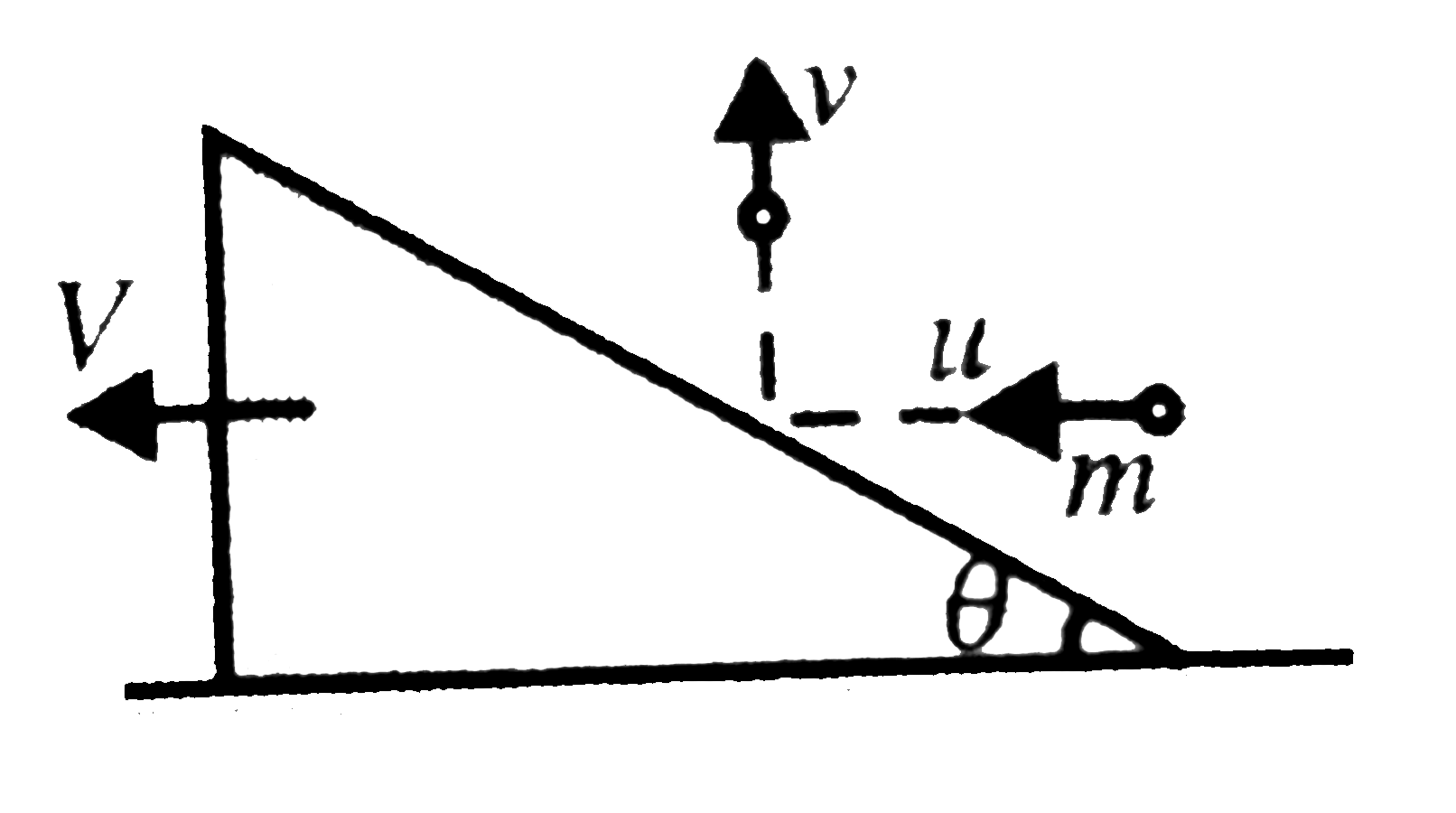 05:22View Solution
05:22View SolutionA wedge of mass `M` is kept at rest on smooth surface a particle of mass `m` hits the wedge normally. Find the velocity of wedge and particle just after collision. Take coefficient of restitution as `e`.
05:48View SolutionA flatcar of mass `m_0` starts moving to the right due to a constant horizontal force F(figure). Sand spills on the flatcar from a stationary hopper. The velocity of loading is constant and equal to `mukg//s`. Find the time dependence of the velocity and the acceleration of the flatcar in the process of loading. The friction is negligibly small.
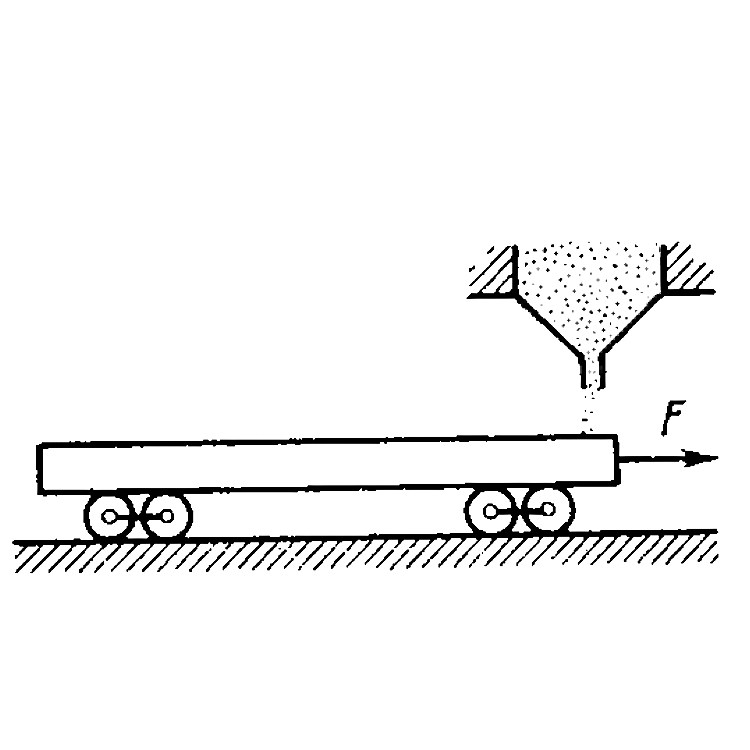 03:27View Solution
03:27View SolutionA cart loaded with sand moves along a horizontal floor due to a constant force `F` coinciding in direction with cart's velocity vector. In the process, the sand spills through a hole in the bottom with a constant rate `mukg//s.` Find the acceleration and velocity of the cart at the moment `t`, if at the initial moment `t=0` the cart with loaded sand had mass `m_(0)` and its velocity was equal to zero. Friction is to be neglected.
05:11View SolutionA rocket with an initial mass of `1000 kg`, is launched vertically upward from rest under gravity. The rocket burns fuel at the rate of `10 kg` per second. The burnt matter is ejected vertically downwards with a speed of `2000 m//s` relative to the rocket . Find the velocity of the rocket after `1 min` of start.
05:18View Solution
Illustration questions and complete solutions for chapter CENTRE OF MASS of CENGAGE PHYSICS (ENGLISH) of Class 11
